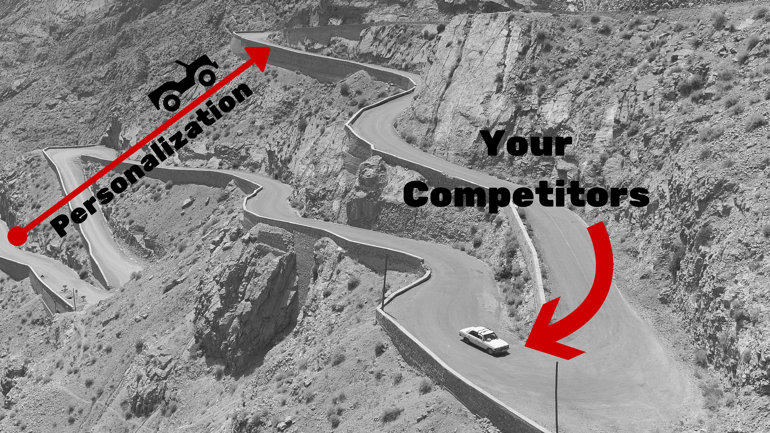Inbound Marketing Blog
for Manufacturers and Healthcare Companies
The Rise of Account-Based Marketing & Extreme Personalization

There's a B2B marketing challenger rising through the ranks of jargon and experimental techniques. It's been around for years but has only recently taken off (as many things are wont to do).
This player is known as account-based marketing.
What is account-based marketing, or ABM? A spin-off of 1-to-1 marketing, it takes a single customer account, identifies all of the influencers within the account (for instance, the buyer you're working with may actually answer to the project manager, an engineer, or a group of higher-ups. Or, the account may be influenced equally by a few different people), and creates a personalized campaign specifically to nurture that account towards a sale. Then, a campaign is created for every account that is already or may become a valuable customer.
On average, 5.4 people now have to formally sign off on each B2B purchase.
Highly personalized marketing is not a new concept. Buyer personas, the buyer's journey, and specific marketing techniques like one-to-one and real-time marketing all espouse the benefits of speaking directly to individual buyers.
Personalized CTAs resulted in a 42% higher conversion rate than generic CTAs.
Studies have shown that personalized content leads to lower bounce rates, higher conversion rates, and larger sales. Notably, BMW improved conversions by 30% by personalizing MMS messages.
There are ways to personalize your website for each individual visitor, and further make their experience unique as they revisit the site. However, that's still an uncommon technique due to its complexity and the amount of effort involved. As technology advances, we can expect to see an increase in ease and usage of fully personalized website experiences.
For now, account-based marketing is where B2B businesses should be focusing their efforts.
92% of companies recognize the value in ABM, calling it a "B2B marketing must-have."
What Makes Account-Based Marketing so Successful?
Ego. All types of personalized marketing play into the strongest of our human desires:
- To be noticed.
- To feel important.
- To feel good about ourselves.
- To feel special.
- To be understood.
Why is astrology still so popular in 2016? Because it throws out general statements about life that we run through our brain's confirmation bias filter, and we take those statements and say ohmygod it's totally talking about me and my life how weird is that? We feel special, because it seems like someone took notice of our personal problems AND gave us advice on how to fix those problems (no matter how general that advice may be).
That's pretty much how marketing personalization works (except the content is business-focused and less vague). If you can make your customers feel all the things listed above, you're sitting pretty.
"
Personally I am very fond of strawberries and cream, but I have found that for some strange reason, fish prefer worms. So when I went fishing, I didn't think about what I wanted. I thought about what they wanted. I didn't bait the hook with strawberries and cream. Rather, I dangled a worm or grasshopper in front of the fish and said: "Wouldn't you like to have that?" Why not use the same common sense when fishing for people?
-Dale Carnegie

Dynamic. ABM uses real-time marketing to make the most of dynamically triggered ads and content. DocuSign is a perfect example of dynamic ABM.
[DocuSign] used ABM to dynamically change their calls to action and messaging for each targeted account who came to their website — so, for example, a T-Mobile employee would have a very different experience than Wells Fargo employee. This dynamic content increased their page views from targeted accounts by 300%, and led to a 22% pipeline growth in their top six industries.
IP Targeting. IP targeting allows marketers to provide a personalized experience even before the targeted account interacts with the company at all. With regular marketing automation, customization requires that cookies latch on to the website visitors, and the information from the cookies provides a new experience the next time that person visits the site.
IP targeting is way more precise and way creepier. It allows marketers to enter the IP address of a specific business office (like, for instance, a certain branch at T-Mobile) and serve dynamic ads and content directly to that IP address. See the DocuSign example above.
Versatility. ABM isn't just for customer acquisition - it's also great for nurturing and expansion. ABM can easily cover all stages of the buyer's journey.
Ease of Use. Perhaps every end user's main concern: how easy is it to implement and use? Turns out, ABM is pretty user-friendly. It requires little management, and the hardest part is IP mapping to get your target accounts set up in your system. Many of the popular ABM providers offer resources to get you started and familiar with best practices.
Internal Benefits. Companies that use ABM tend to have a better sales-marketing alignment, close bigger deals with target accounts, and increase pipeline velocity. It's also easier to track ROI and other results, since there's a smaller pool of accounts.
Ideal Buyers. What's the greatest perk of ABM? You're basically handpicking your own clients. You can choose accounts that will bring in the most revenue, or you can choose companies whose values align tightly with yours.
How Can You Get Started With Account-Based Marketing?
Aside from completely revamping your marketing tactics, there are a few easy things you can do to get started.
The first step is to make a list of accounts to target. Who do you want to take on as customers? This is different from building buyer personas in that you want to identify a specific account. Personas are more archetypal.

For each account, identify the influencers and decision makers. Who is ultimately responsible for a purchase decision? What are they concerned about when they make that decision?
Produce content that speaks directly to those individual decision makers. If you're targeting GE's R&D team, you'd better speak their language, because they simply don't have time to waste on amateur nonsense. Smaller businesses will be a little more flexible on that front. No matter who you're targeting, provide content that is relevant and valuable to them.
A/B Test. Try two different variations of a CTA, one with a red background and one with blue. Which one performs better? Use that color, then try two different variations of copy (Contact Us! vs. Set Up a Free Consultation!). Use the more effective wording, then try two different shapes. And so on, and so on.
Track your results. Always track your results. Today, all of your online marketing efforts can be measured through Google Analytics, your CRM, and whatever CMS you're using. The results will allow you to implement smarter changes and plan more effectively for each new campaign.
B2B Personalization Is the Future
Once you've gotten started with these basic personalization techniques, dive deeper into ABM. Learn how exactly to target accounts of your choosing. Learn what makes those people tick. Be unabashedly creepy in your quest for great clients.
Personalized marketing is an absolute necessity in the modern marketing world. If you're still practicing the "spray 'n' pray" method, it's time for a marketing overhaul. ABM might be exactly what you need.
Our Blogs, Direct to Your Inbox!
How to Audit your Online Marketing
If you are executing digital marketing, congratulations! You are most likely already one step ahead of your competition, and making strides to meaningfully connect with prospects online. But, how do you know if you’re seeing continual success year over year, and improving your metrics?
Without the tools in place to analyze and benchmark your efforts, it is impossible to scale your online marketing and ensure continuous success.


